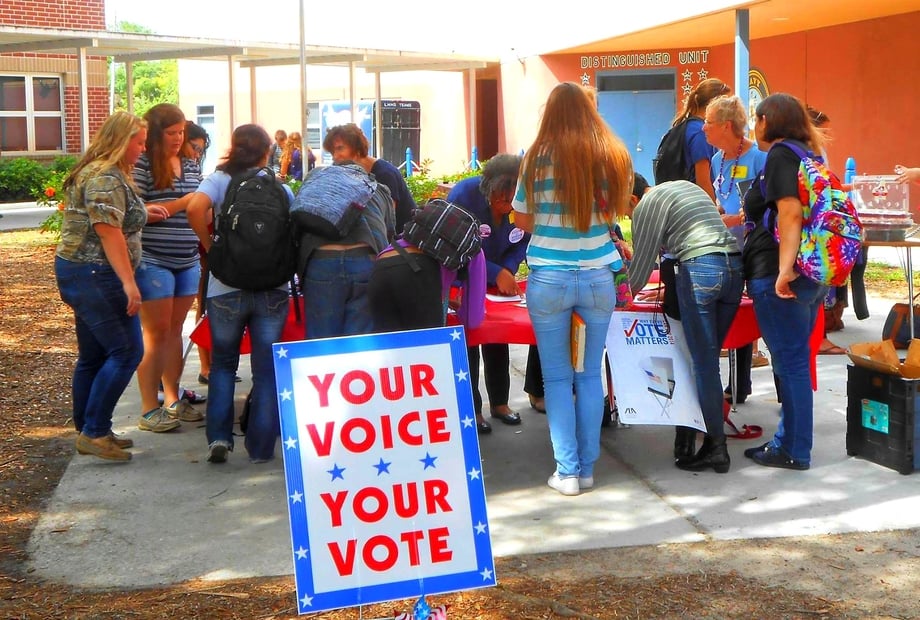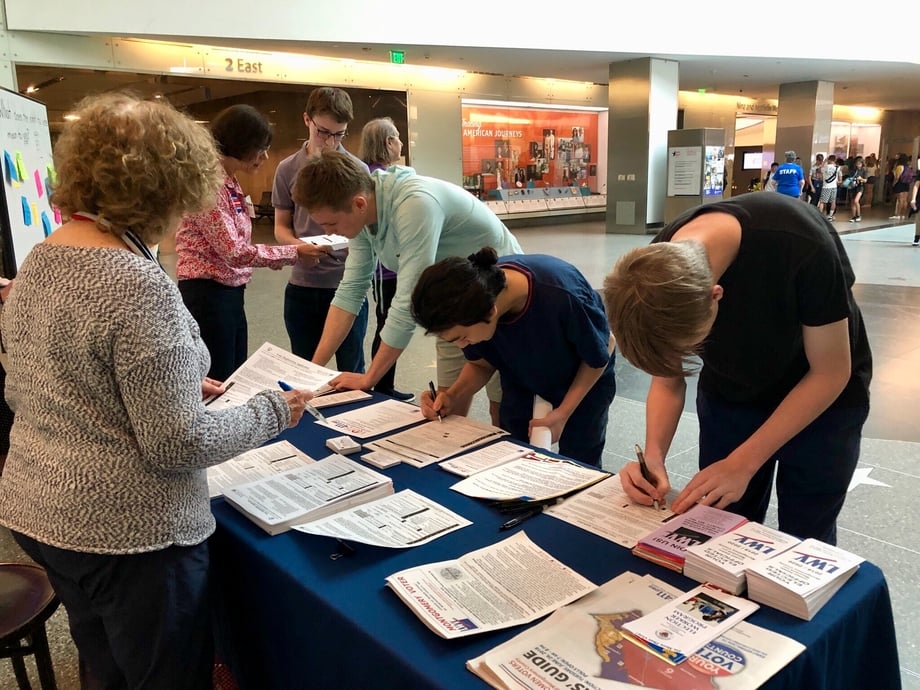Challenges Facing Student Voters
Young voters are becoming a force in American politics. While only 13% of people aged 18-29 voted in 2014, that percentage skyrocketed to 28% in 2018 and stayed high in 2022 at 23%.
Young people’s votes matter — and as a result, anti-voter state legislatures are going to great lengths to add hurdles for young voters. Despite these barriers, young voters are energetic, organized, and ready to make their voices heard.
The freedom to vote still has many defenders, in and outside of government. Many states are empowering voters to cast their ballots, particularly young and student voters. In 2024, for example, at least 11 states enacted 14 expansive voting laws.
Stay Updated
Keep up with the latest news on elections and democracy. Receive emails to your inbox!
Yet, as mentioned above, in other states, anti-voter legislation has made it more challenging to cast a ballot and have it counted. These laws disproportionately impact younger voters.
College students have been a particular target for anti-voter legislatures, though this demographic doesn’t let attempted voter suppression keep them from staying politically engaged. The fact that 23% of eligible young people voted in 2022 despite laws targeting young voters is a victory. But it’s critical to dismantle these barriers and make it easier for the remaining 77% to join them.
This blog explores how advocates and student voters — just one portion of the young voter population — are fighting back against voter suppression.
Voting in Person
Voter ID Laws
Eleven states have “strict” photo ID laws, requiring in-person voters to present government-issued photo identification, such as a state driver’s license, at their polling location. In those 11 states, voters who don’t have photo ID must follow additional steps to cast their ballot. In 14 additional states, a photo ID is requested for voting, but voters without photo IDs can still vote without additional steps. Twelve of the 25 states that require or request photo ID do not accept student IDs for voting. These requirements pose a particular burden on certain populations, including young people.

For example, young people in schools outside their home states may face barriers around state-issued IDs. In 2018, students attending a college or university outside of their home state made up at least 25% of student enrollment in 23 states. Many of these out-of-state students retain their home state residence while in school, which means they may not be able to get government-issued photo identification in their college or university’s state. This complicates the process of presenting accepted photo IDs at polling stations. While driver’s licenses are used by many as voter ID, the number of young people with driver’s licenses is also decreasing. The increased use of ride-share options and Gen Z’s focus on environmental consciousness mean this trend will likely continue. With driver's licenses less common for younger people, photo ID laws become all the more restrictive.
Non-photo ID requirements can also create challenges for young voters. Four states require non-photo identification to vote. Voters who arrive without that identification must take additional steps to vote. Some states accept documentation like utility bills or bank statements showing a student’s school address as identification. While these forms of identification are easier for students to obtain, even these laws can be a barrier for students.
Visit VOTE411.org to Learn What ID You Need!
For instance, many colleges, universities, and work programs geared toward young people require participants to live in a campus-like environment, at least in the first year. These people usually don’t get documents like utility bills, which makes proof of residence more challenging when it comes time to vote.
Student voters are not taking these barriers lightly; in fact, they have brought numerous lawsuits to challenge laws that target them. For example, the League of Women Voters of Idaho joined students in the state to challenge a law that eliminated student ID as an acceptable form of identification for in-person voting. The League claims that this law violates equal protection, as it constitutes illegal age discrimination, and impairs the fundamental right to vote. Students also challenged this law in federal court; at the time of this blog’s publication, the case is pending.

Transportation
Access to polling places near campus is inconsistent across the country, posing a barrier to young voters who lack reliable transportation. It can be hard for students to arrange transportation to the polls, particularly in locations without public transit, like the Deep South. Students often can’t afford to take ride shares, and campuses in more rural areas may have inconsistent rideshare access.
Further, a single college campus may be split into multiple voting districts during redistricting. When that happens, students who live on one end of campus may have a different polling place than students living on the other side; not only is this confusing, it means transportation needs will vary from student to student.
Voter Registration
In 2023, North Carolina passed SB 747. Among other provisions, during early voting dates it allows election officials to cancel a “Same Day Voter’s” (someone who registered and voted on the same day) registration and vote a single address verification mailer is returned as undeliverable. The League of Women Voters of North Carolina and others challenged this law on the grounds that it violates voter’s due process rights, places an undue burden on the right to vote in violation of the First and Fourteenth Amendments, and constitutes impermissible age discrimination under the Twenty-Sixth Amendment. Thanks to the League’s litigation and a related case, this portion of the law was put on hold in January 2024.
Empower young voters in your community by joining your local League.
Absentee Voting
Many college students vote using an absentee or mail ballot. Voting absentee or by mail is a secure, reliable way to cast a ballot in every state, and it is widely accessible in most states.
Yet, in the wake of the 2020 election, when exponential numbers of voters used absentee ballots to protect themselves during the COVID-19 pandemic, anti-voter state legislatures in several states imposed additional requirements for absentee voters, increasing opportunities for absentee ballots to be rejected. These rejections are usually the result of the voter not following minor technical instructions, like writing the wrong date or signing in the wrong place.
The risk of suppression is highest in the states that do not provide a “notice and cure” process for absentee ballots, which allows voters to be notified of and have an opportunity to remedy any deficiencies in their absentee ballot. Numerous lawsuits have been filed around these non-material yet burdensome requirements. In response, states are compelled to not unreasonably reject an absentee ballot and allow voters to cure any problems. The League has ongoing challenges related to absentee restrictions in Georgia, Pennsylvania, Texas, Alabama, Mississippi, and Ohio.

Anti-voter state legislatures and third-party organizations are currently focused on decreasing the period within which an absentee ballot can be counted, even those postmarked or received by Election Day. For example, at least two attempts have been made to require states to count all absentee ballots on or by Election Day. This burdens election workers, who should be allowed the time needed to do their jobs thoroughly and carefully.
Two state Leagues — the League of Women Voters of Mississippi and the League of Women Voters of North Dakota — recently fought back against these attempts. In both cases, the League sought to intervene on behalf of voters who could be disenfranchised by a change in state law. The case in Mississippi is pending, and the case in North Dakota was successfully dismissed.
Department of Education’s Toolkit for Student Voters
The Department of Education recently released a Toolkit for the Promotion of Voter Participation for Students. The toolkit is geared towards colleges and universities, but all young voters might find the information helpful. For instance, the Department of Education linked resources for new voters and voters who will be abroad for an election. Additionally, the Department of Education clarified that federal work-study funds may allow eligible students to be compensated through federal work-study for working in nonpartisan voting efforts.

What Can I Do?
If you are a student voter (or you know one!), you can learn how to register to vote or check your registration at VOTE411.org. Through our young voter engagement programs, the League registered 19,000 young people in the first half of 2023 alone.
Young and college-attending voters might also find our First-Time Voter Checklist and our Make a Plan to Vote Checklist useful, as they provide answers to common questions like where students should register to vote and what to bring to the polls.
Finally, you can encourage your young friends and family to use these resources to make casting their ballot as simple as possible.
Sign Up For Email
Keep up with the League. Receive emails to your inbox!
Donate to support our work
to empower voters and defend democracy.





